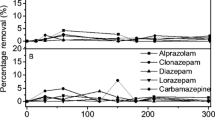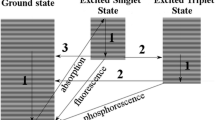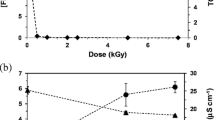Abstract
Photoperoxidation (UV/H2O2) was used to degrade three of the worldwide most consumed antidepressant pharmaceuticals—bupropion, escitalopram, and fluoxetine—in ultrapure water, drinking tap water, surface water, and reclaimed water. The study was performed with antidepressants in concentration levels in which these compounds usually occur in the water matrices. Online solid-phase extraction coupled to UHPLC-MS/MS was used to quantify the analytes during degradation studies. The UV/H2O2 process was able to degrade bupropion and fluoxetine in ultrapure water, using 0.042 mmol L−1 of H2O2 and 1.9 kJ of UV-C irradiation. Nevertheless, escitalopram, which had the most recalcitrant character among the studied antidepressants, needed a tenfold more oxidant and UV-C irradiation. The primary metabolites of the antidepressants were identified as the major by-products generated by the UV/H2O2 process, and they persisted in the solution even when the parent compound was degraded. The residual toxicity of the solution was evaluated for two different trophic levels. The UV/H2O2 process reduced the toxicity of the solution to Raphidocelis. subcapitata microalgae after 30 min of reaction. On the other hand, the toxicity of the residual solution increased over the reaction time to the marine bacteria Vibrio fischeri (reaching up to 48.3% of bioluminescence inhibition after 60 min of reaction). Thus, our results evidenced that the toxicity against different trophic levels and the monitoring of the by-products formed are important aspects to be considered regarding the safety of the treated solution and the optimization of the treatment process.




Similar content being viewed by others
Data availability
All data generated or analyzed during this study are included in this published article and its supplementary information files. The datasets used and/or analyzed during the current study are available from the corresponding author on reasonable request.
References
Abbas M, Adil M, Ehtisham-ul-Haque S, Munir B, Yameen M, Ghaffar A, Shar GA, Asif Tahir M, Iqbal M (2018) Vibrio fischeri bioluminescence inhibition assay for ecotoxicity assessment: a review. Sci Total Environ 626:1295–1309. https://doi.org/10.1016/j.scitotenv.2018.01.066
Associação Brasileira de Normas Técnicas (ABNT) (2018) NBR 12648: Ecotoxicologia aquática—Toxicidade crônica—Método de ensaio com algas (Chlophyceae), 2nd edn. Author, Rio de Janeiro, 27 pp
ANVISA AN de VS (2019) http://portal.anvisa.gov.br/consulta-produtos-registrados. Accessed 1 Jul 2020
Bansal R, Saini B, Bansal Y, Bansal G (2013) MSn, LC-MS-TOF and LC-PDA studies for identification of new degradation impurities of bupropion. Biomed Chromatogr 27:1387–1397. https://doi.org/10.1002/bmc.2933
Besse J-P, Kausch-Barreto C, Garric J (2008) Exposure assessment of pharmaceuticals and their metabolites in the aquatic environment: application to the French situation and preliminary prioritization. Hum Ecol Risk Assess An Int J 14:665–695. https://doi.org/10.1080/10807030802235078
Białk-Bielińska A, Caban M, Pieczyńska A, Stepnowski P, Stolte S (2017) Mixture toxicity of six sulfonamides and their two transformation products to green algae Scenedesmus vacuolatus and duckweed Lemna minor. Chemosphere 173:542–550. https://doi.org/10.1016/J.CHEMOSPHERE.2017.01.035
Brooks BW, Turner PK, Stanley JK, Weston JJ, Glidewell EA, Foran CM, Slattery M, la Point TW, Huggett DB (2003) Waterborne and sediment toxicity of fluoxetine to select organisms. Chemosphere 52:135–142. https://doi.org/10.1016/S0045-6535(03)00103-6
Caianelo M, Rodrigues-Silva C, Maniero MG, Guimarães JR (2016) Antimicrobial activity against gram-positive and gram-negative bacteria during gatifloxacin degradation by hydroxyl radicals. Environ Sci Pollut Res 24:6288–6298. https://doi.org/10.1007/s11356-016-6972-y
Cao J, Jiang R, Wang J, Sun J, Feng Q, Zhao Z, Chen G, Zhou C, Yin E (2018) Study on the interaction mechanism between cefradine and Chlamydomonas reinhardtii in water solutions under dark condition. Ecotoxicol Environ Saf 159:56–62. https://doi.org/10.1016/J.ECOENV.2018.04.068
Carballa M, Omil F, Lema JM (2008) Comparison of predicted and measured concentrations of selected pharmaceuticals, fragrances and hormones in Spanish sewage. Chemosphere 72:1118–1123. https://doi.org/10.1016/J.CHEMOSPHERE.2008.04.034
Christensen AM, Faaborg-Andersen S, Ingerslev F, Baun A (2007) Mixture and single-substance toxicity of selective serotonin reuptake inhibitors toward algae and crustaceans. Environ Toxicol Chem 26:85–91. https://doi.org/10.1897/06-219R.1
Perini JAL, Silva BC, Tonetti AL, Nogueira RFP (2017) Photo-Fenton degradation of the pharmaceuticals ciprofloxacin and fluoxetine after anaerobic pre-treatment of hospital effluent. Environ Sci Pollut Res 24:6233–6240. https://doi.org/10.1007/s11356-016-7416-4
De Oliveira AMD, Maniero MG, Rodrigues-Silva C, Guimarães JR (2017) Antimicrobial activity and acute toxicity of ozonated lomefloxacin solution. Environ Sci Pollut Res 24:6252–6260. https://doi.org/10.1007/s11356-016-8319-0
Environmental Agency (2008) Review of human pharmaceuticals in the environment. UK
Forns J, Pottegård A, Reinders T, Poblador-Plou B, Morros R, Brandt L, Cainzos-Achirica M, Hellfritzsch M, Schink T, Prados-Torres A, Giner-Soriano M, Hägg D, Hallas J, Cortés J, Jacquot E, Deltour N, Perez-Gutthann S, Pladevall M, Reutfors J (2019) Antidepressant use in Denmark, Germany, Spain, and Sweden between 2009 and 2014: incidence and comorbidities of antidepressant initiators. J Affect Disord 249:242–252. https://doi.org/10.1016/J.JAD.2019.02.010
Galbraith A, Bullock S, Manias E, et al (2004) Pharmacokinetics: absorption and distribution. In: fundamentals of pharmacology : a text for nurses and health professionals, 4 ed. Addison Wesley Longman, p 792
GDB (2016) Global, regional, and national incidence, prevalence, and years lived with disability for 310 diseases and injuries, 1999–2015: a systematic analysis for the Global Burden of Disease Study 2015
Himmerich HW, Wranik D (2012) Choice of treatment with antidepressants: influencing factors. Curr Pharm Des 18:5958–5975. https://doi.org/10.2174/138161212803523653
IQVIA (2019) Subscription online database for API use. São Paulo
Johnson DJ, Sanderson H, Brain RA, Wilson CJ, Solomon KR (2007) Toxicity and hazard of selective serotonin reuptake inhibitor antidepressants fluoxetine, fluvoxamine, and sertraline to algae. Ecotoxicol Environ Saf 67:128–139. https://doi.org/10.1016/j.ecoenv.2006.03.016
Kakde RB, Satone DD, Gadapayale KK, Kakde MG (2013) Stability-indicating RP-HPLC method for the simultaneous determination of escitalopram oxalate and clonazepam. J Chromatogr Sci 51:490–495. https://doi.org/10.1093/chromsci/bms177
Khaleel NDH, Mahmoud WMM, Olsson O, Kümmerer K (2016) UV-photodegradation of desipramine: impact of concentration, pH and temperature on formation of products including their biodegradability and toxicity. Sci Total Environ 566–567:826–840. https://doi.org/10.1016/j.scitotenv.2016.05.095
Klaassen CD (2008) Casaret& Doull’s - toxicology:the basic science od poisons, 7th Ed.
Lam MW, Young CJ, Mabury SA (2005) Aqueous photochemical reaction kinetics and transformations of fluoxetine. Environ Sci Technol 39:513–522. https://doi.org/10.1021/es0494757
Lin AYC, Reinhard M (2005) Photodegradation of common environmental pharmaceuticals and estrogens in river water. Environ Toxicol Chem 24:1303–1309. https://doi.org/10.1897/04-236R.1
Lopes CD, Goytacazes AF, Marques M (2017) Psychoactive drugs: occurrence in aquatic environment, analytical methods, and ecotoxicity-a review. Environ Sci Pollut Res 24:2407624091–2407624091. https://doi.org/10.1007/s11356-017-0170-4
Ma L-d, Li J, Li JJ, Liu M, Yan D-z, Shia W-y, Xu G (2018) Occurrence and source analysis of selected antidepressants and their metabolites in municipal wastewater and receiving surface water. Environ Sci Process Impacts 20:1020–1029. https://doi.org/10.1039/c8em00077h
Malato S, Fernández-Ibáñez P, Maldonado MI, Blanco J, Gernjak W (2009) Decontamination and disinfection of water by solar photocatalysis: recent overview and trends. Catal Today 147:1–59
Mansano AS, Moreira RA, Dornfeld HC, Freitas EC, Vieira EM, Sarmento H, Rocha O, Seleghim MHR (2017) Effects of diuron and carbofuran and their mixtures on the microalgae Raphidocelis subcapitata. Ecotoxicol Environ Saf 142:312–321. https://doi.org/10.1016/j.ecoenv.2017.04.024
Minagh E, Hernan R, O’Rourke K, Lyng FM, Davoren M (2009) Aquatic ecotoxicity of the selective serotonin reuptake inhibitor sertraline hydrochloride in a battery of freshwater test species. Ecotoxicol Environ Saf 72:434–440. https://doi.org/10.1016/j.ecoenv.2008.05.002
Minguez L, Bureau R, Halm-Lemeille MP (2018) Joint effects of nine antidepressants on Raphidocelis subcapitata and Skeletonema marinoi: a matter of amine functional groups. Aquat Toxicol 196:117–123. https://doi.org/10.1016/j.aquatox.2018.01.015
Monteiro SC, Boxall ABA (2010) Occurrence and fate of human pharmaceuticals in the environment. Springer, New York, pp 53–154
Moore TJ, Mattison DR (2017) Adult utilization of psychiatric drugs and differences by sex, age, and race. JAMA Intern Med 177:274–275. https://doi.org/10.1001/jamainternmed.2016.7507
Neuwoehner J, Fenner K, Escher BI (2009) Physiological modes of action of fluoxetine and its human metabolites in algae. Environ Sci Technol 43:6830–6837. https://doi.org/10.1021/es9005493
Nogueira R, Oliveira M, Paterlini W (2005) Simple and fast spectrophotometric determination of H2O2 in photo-Fenton reactions using metavanadate. Talanta 66(1):86–91
Nygaard G, Komárek J, Kristiansen J, Skulberg OM (1987) Taxonomic designations of the bioassay alga NIVA-CHL 1 (“Selenastrum capricornutum”) and some related strains /. Opera Bot 90:1–46
O’Byrne PM, Williams R, Walsh JJ, Gilmer JF (2010) The aqueous stability of bupropion. J Pharm Biomed Anal 53:376–381. https://doi.org/10.1016/j.jpba.2010.04.024
Oakes KD, Coors A, Escher BI, Fenner K, Garric J, Gust M, Knacker T, Küster A, Kussatz C, Metcalfe CD, Monteiro S, Moon TW, Mennigen JA, Parrott J, Péry ARR, Ramil M, Roennefahrt I, Tarazona JV, Sánchez-Argüello P, Ternes TA, Trudeau VL, Boucard T, van der Kraak GJ, Servos MR (2010) Environmental risk assessment for the serotonin re-uptake inhibitor fluoxetine: case study using the European risk assessment framework. Integr Environ Assess Manag 6:524–539. https://doi.org/10.1002/ieam.77
Organization for Economic Cooperation & Development (OECD) (2011) OECD guideline for testing of chemicals, 201 (Alga, Growth Inhibition Test), Paris
Oller I, Malato S, Sánchez-Pérez JA (2011) Combination of advanced oxidation processes and biological treatments for wastewater decontamination-a review. Sci Total Environ 409:4141–4166. https://doi.org/10.1016/j.scitotenv.2010.08.061
Pinto AC, Barreiro EJ (2013) Desafios da indústria farmacêutica Brasileira. Quim Nova 36:1557–1560. https://doi.org/10.1590/S0100-40422013001000012
Pivetta RC, Rodrigues-Silva C, Ribeiro AR, Rath S (2020) Tracking the occurrence of psychotropic pharmaceuticals in Brazilian wastewater treatment plants and surface water, with assessment of environmental risks. Sci Total Environ 727:138661. https://doi.org/10.1016/j.scitotenv.2020.138661
Rizzo L (2011) Bioassays as a tool for evaluating advanced oxidation processes in water and wastewater treatment. Water Res 45:4311–4340. https://doi.org/10.1016/j.watres.2011.05.035
Saggioro EM, Oliveira AS, Buss DF, Magalhães DP, Pavesi T, Jimenéz M, Maldonado MI, Ferreira LFV, Moreira JC (2015) Photo-decolorization and ecotoxicological effects of solar compound parabolic collector pilot plant and artificial light photocatalysis of indigo carmine dye. Dyes Pigments 113:571–580. https://doi.org/10.1016/j.dyepig.2014.09.029
Salgado R, Marques R, Noronha JP, Mexia JT, Carvalho G, Oehmen A, Reis MAM (2011) Assessing the diurnal variability of pharmaceutical and personal care products in a full-scale activated sludge plant. Environ Pollut 159:2359–2367. https://doi.org/10.1016/J.ENVPOL.2011.07.004
Shao HY, Wu MH, Deng F et al (2018) Electron beam irradiation induced degradation of antidepressant drug fluoxetine in water matrices. Chemosphere 190:184–190. https://doi.org/10.1016/j.chemosphere.2017.09.133
Spina-Cruz M, Maniero MG, Guimarães JR (2018) Advanced oxidation processes on doxycycline degradation: monitoring of antimicrobial activity and toxicity. Environ Sci Pollut Res 26:27604–27619. 1–16. https://doi.org/10.1007/s11356-018-2149-1
Tanoue R, Margiotta-Casaluci L, Huerta B, Runnalls TJ, Eguchi A, Nomiyama K, Kunisue T, Tanabe S, Sumpter JP (2019) Protecting the environment from psychoactive drugs: problems for regulators illustrated by the possible effects of tramadol on fish behaviour. Sci Total Environ 664:915–926. https://doi.org/10.1016/j.scitotenv.2019.02.090
Teitelbaum AM, Flaker AM, Kharasch ED (2016) Development, validation and application of a comprehensive stereoselective LC/MS-MS assay for bupropion and oxidative, reductive, and glucuronide metabolites in human urine. J Chromatogr B Anal Technol Biomed Life Sci 1027:239–253. https://doi.org/10.1016/j.jchromb.2016.05.036
Tetzner NF, Maniero MG, Rodrigues-Silva C, Rath S (2016) On-line solid phase extraction-ultra high performance liquid chromatography-tandem mass spectrometry as a powerful technique for the determination of sulfonamide residues in soils. J Chromatogr A 1452:89–97. https://doi.org/10.1016/j.chroma.2016.05.034
Trawiński J, Skibiński R (2017) Studies on photodegradation process of psychotropic drugs: a review. Environ Sci Pollut Res 24:1152–1199. https://doi.org/10.1007/s11356-016-7727-5
Urbano VR, Guedes M, Pèrez-Moya M, Guimarães JR (2017a) Influence of pH and ozone dose on sulfaquinoxaline ozonation. J Environ Manag 195:224–232. https://doi.org/10.1016/j.jenvman.2016.08.019
Urbano VR, Peres MS, Maniero MG, Guimarães JR (2017b) Abatement and toxicity reduction of antimicrobials by UV/H2O2 process. J Environ Manag 193:439–447. https://doi.org/10.1016/j.jenvman.2017.02.028
Välitalo P, Kruglova A, Mikola A, Vahala R (2017) Toxicological impacts of antibiotics on aquatic micro-organisms: a mini-review. Int J Hyg Environ Health 220:558–569. https://doi.org/10.1016/J.IJHEH.2017.02.003
Silva VHO, dos Santos Batista AP, Silva AC et al (2016) Degradation and acute toxicity removal of the antidepressant fluoxetine (Prozac®) in aqueous systems by electron beam irradiation. Environ Sci Pollut Res 23:11927–11936. https://doi.org/10.1007/s11356-016-6410-1
Venancio WAL, Rodrigues-Silva C, Maniero MG, Guimarães JR (2018) Photocatalytic removal of fluoroquinolones and their antimicrobial activity from water matrices at trace levels: a comparison of commercial TiO 2 catalysts. Water Sci Technol 78:1668–1678. https://doi.org/10.2166/wst.2018.443
Walker CH, Hopkin SP, Sibly RM, Peakall DB (2006) Principles of ecotoxicology, 3o edn. Taylor & Francis, Boca Raton
Wang C, Niu J, Yin L, Huang J, Hou LA (2018) Electrochemical degradation of fluoxetine on nanotube array intercalated anode with enhanced electronic transport and hydroxyl radical production. Chem Eng J 346:662–671. https://doi.org/10.1016/j.cej.2018.03.159
World Health Organization (2017) Depression and other common mental disorders: global health estimates
Writer JH, Ferrer I, Barber LB, Thurman EM (2013) Widespread occurrence of neuro-active pharmaceuticals and metabolites in 24 Minnesota rivers and wastewaters. Sci Total Environ 461–462:519–527. https://doi.org/10.1016/J.SCITOTENV.2013.04.099
Yan Z, Lu G, Sun H, Bao X, Jiang R, Liu J, Ji Y (2019) Comparison of the accumulation and metabolite of fluoxetine in zebrafish larva under different environmental conditions with or without carbon nanotubes. Ecotoxicol Environ Saf 172:240–245. https://doi.org/10.1016/j.ecoenv.2019.01.089
Yu HW, Anumol T, Park M, Pepper I, Scheideler J, Snyder SA (2015) On-line sensor monitoring for chemical contaminant attenuation during UV/H2O2 advanced oxidation process. Water Res 81:250–260. https://doi.org/10.1016/j.watres.2015.05.064
Zhao Y, Yu G, Chen S, Zhang S, Wang B, Huang J, Deng S, Wang Y (2017) Ozonation of antidepressant fluoxetine and its metabolite product norfluoxetine: kinetics, intermediates and toxicity. Chem Eng J 316:951–963. https://doi.org/10.1016/j.cej.2017.02.032
Acknowledgments
The authors gratefully acknowledge CAPES for the scholarships granted to M. Spina and W.A.Venâncio, and CNPq for the scholarship awarded to R. C. Pivetta and C. Rodrigues-Silva (CNPq, #154061/2018-2). The authors also thank the collaboration of SANASA (Sociedade de Abastecimento e Água e Saneamento, Campinas, SP. Brazil). Financial support was provided by Brazilian agencies, such as The São Paulo Research Foundation – FAPESP, BRAZIL (grants #2013/09543-7, #2018/03571-2 and INCTAA-FAPESP #2014/50951-4).
Funding
The financial support was provided by FAPESP, CAPES and CNPq. The detailed funding grant number are highlighted in the Acknowledgements section.
Author information
Authors and Affiliations
Contributions
All authors contributed to the study conception and design. Mylena Spina: method, validation, formal analysis, investigation, visualization, writing - original fraft, and writing - review and editing. Wilson Augusto Lima Venancio: method, validation, formal analysis, investigation, and visualization. Caio Rodrigues-Silva: method, writing - original draft, writing - review and editing, resources, and formal analysis. Rhannanda Copetti Pivetta: analytical method validation. Vinicius Diniz: formal analysis, writing - original draft, and visualization. José Roberto Guimarães: supervision, project administration, and funding acquisition. Susanne Rath: project administration and funding acquisition. The first draft of the manuscript was written by Mylena Spina, Caio Rodrigues-Silva, and Vinicius Diniz, and all authors commented on previous versions of the manuscript. All authors read and approved the final and revised manuscript.
Corresponding authors
Ethics declarations
Competing interests
The authors declare that they have no competing interests.
Ethical approval, consent to participate, and consent to publish
Not applicable.
Additional information
Responsible Editor: Vítor Pais Vilar
Publisher’s note
Springer Nature remains neutral with regard to jurisdictional claims in published maps and institutional affiliations.
Supplementary Information
ESM 1
(DOCX 511 kb)
Rights and permissions
About this article
Cite this article
Spina, M., Venâncio, W., Rodrigues-Silva, C. et al. Degradation of antidepressant pharmaceuticals by photoperoxidation in diverse water matrices: a highlight in the evaluation of acute and chronic toxicity. Environ Sci Pollut Res 28, 24034–24045 (2021). https://doi.org/10.1007/s11356-020-11657-4
Received:
Accepted:
Published:
Issue Date:
DOI: https://doi.org/10.1007/s11356-020-11657-4




